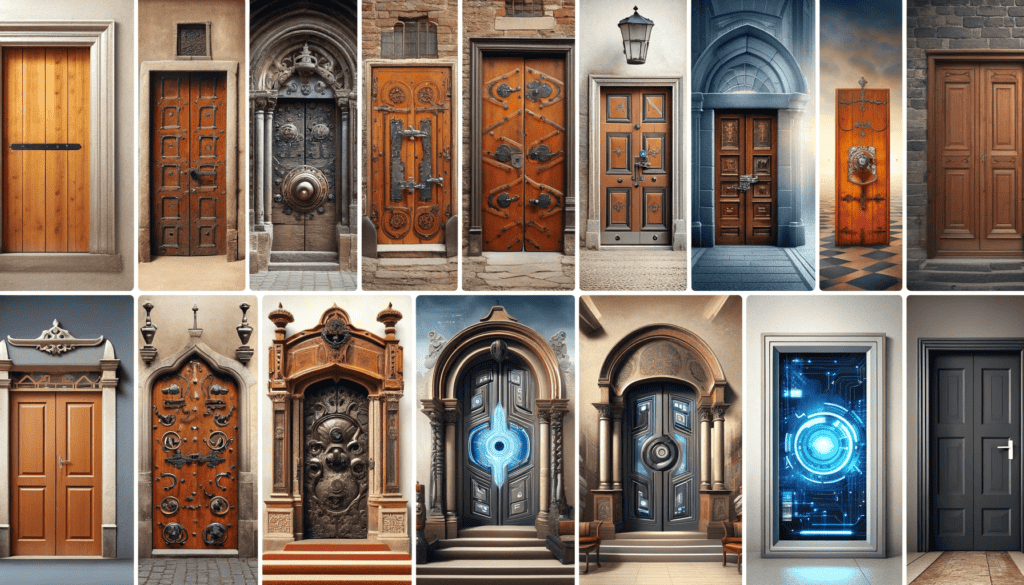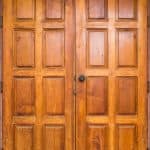
Doors are such a ubiquitous part of our everyday lives that it’s easy to overlook their rich history and cultural significance. Yet behind every door lies a fascinating story waiting to be discovered. This article takes you on an enlightening tour through the world of doors, unveiling surprising facts, innovations, records, and perspectives that will completely change how you view these architectural portals.
Whether you’re a trivia buff, history enthusiast, or design professional, you’ll uncover intriguing details about everything from ancient doors to modern technological advancements. Get ready to step through the doorway into a captivating realm of all things doors!
Doors have been an integral part of human civilization for thousands of years, serving the essential functions of providing privacy, security, temperature control, and transition between spaces. They have evolved tremendously, adapting to cultural trends and architectural styles.
Beyond their practical purposes, doors hold powerful symbolic meaning in religion, literature, and art. They represent mystery, opportunity, rites of passage, protection, and more.
This article chronicles the journey of doors across cultures and eras, spotlighting record-breaking specimens, artistic symbolism, and industry insights. You’ll uncover mind-boggling statistics, pioneers in door technology, and perspectives on doors that will change how you view them forever.
By the end, your eyes will be opened to the deceptively complex and intriguing world of doors. You’ll never look at an entranceway the same way again!
Key Takeaways: Startling Door Facts and Statistics
Before diving into door history, here are some mind-blowing facts about these often-overlooked architectural elements:
- The world’s oldest door is over 5,000 years old, discovered in Switzerland and built around 3,000 BC.
- The largest door in the world is at NASA’s Vehicle Assembly Building in Florida, standing 456 feet tall and weighing 756 feet wide.
- The heaviest door in the world is on the Grand Coulee Dam in Washington state, weighing a colossal 321.4 tons.
- The fastest-closing automated door takes just 0.03 seconds to shut completely.
- The average American home contains around 10 doors.
- Doors account for 11% of energy lost through the exterior of a home.
Keep these staggering stats in mind as we uncover the events and innovations that led to these record-breaking accomplishments!
Oldest and Largest Doors
The World’s Oldest Door
In 2010, archaeologists in Switzerland uncovered a fascinating artifact – the oldest intact door ever discovered. Dated to around 3000 BC, this Neolithic wooden door was amazingly well preserved in the oxygen-deficient layer of peat.
Fashioned from a single slab of timber and measuring only 19 inches high, the 5,000-year-old door still bears visible carpentry marks. Its hinges are designed to pivot on sockets carved within the wood.
This remarkable relic provides valuable insights into the sophisticated carpentry skills and structural know-how of Copper Age humans. It also marks the earliest evidence of doors used for partitioning interior spaces.
The World’s Largest Door
The title for the world’s largest door belongs to the grand portal of NASA’s iconic Vehicle Assembly Building at Kennedy Space Center in Florida.
This towering behemoth stands 456 feet high and spans 756 feet wide, made up of individual 45-foot-tall vertical panels, each weighing a whopping 120 tons.
To put things in perspective, you could fit almost nine Statues of Liberty standing on top of each other in the gap between the top of this mega-door and the ground! Or over $2 billion worth of gold Krugerrands stacked up.
The colossal entrance was initially constructed in 1965 to enable the integration of massive Saturn V rockets and the shuttle transport system for NASA’s Apollo missions.
Fun fact: it takes 45 minutes for the enormous structure to completely open or close!
Record-Breaking Doors
In addition to the oldest and biggest, there are also records for the heaviest and fastest doors:
The Heaviest Door
The title for the world’s heaviest door goes to a water intake gate at the Grand Coulee Dam in Washington state, weighing a monumental 321.4 tons!
Spanning 92 feet, this enormous steel gate forms part of the maintenance facilities for the dam’s pump-generating plant reactor.
To provide a sense of how hefty this door is, that’s about the same as 13 blue whales or over 2,300 average-sized pianos! Takes the term “dead weight” to a whole new level.
The Fastest-Closing Door
At the opposite end of the spectrum, the world’s fastest automated door takes just 0.03 seconds to seal shut completely, as verified by Guinness World Records.
These ultra-high-speed doors are designed for sensitive facilities like pharmaceutical cleanrooms, hazardous material labs, and food preparation areas. Their blindingly quick action effectively isolates controlled environments while allowing multiple openings per minute.
The rapid opening and closing are achieved using a durable, lightweight fabric instead of rigid panels. The fabric rolls up horizontally using an electric motor to enable the warp-speed operation.
It’s pretty mind-blowing to watch a fully closed door appear instantly before your eyes in the literal blink of an eye!
Doors in the Average Home
Beyond the record setters, doors also play an integral role in regular households:
Number of Doors in US Homes
The average single-family home in America has around 10 doors, according to surveys and assessment data. This includes exterior entry and side doors and interior doors to bedrooms, bathrooms, closets, pantries, etc.
Of course, the exact number varies considerably based on a home’s size, floor plan, and style. Master-planned estates could have 50+ doors, while tiny homes may only have 2 or 3.
But across the board, doors outnumber people in most houses – an exciting indicator of the prevalence and functionality of doors in everyday domestic spaces.
Doors and Home Energy Efficiency
Here’s a surprising fact about home construction: doors account for around 11% of heat loss from the exterior of a typical house. This is due to air leakage around the edges and through the doors.
Given the energy-draining impact of doors, it’s critical to have proper weather stripping and insulation. Energy-efficient glass doors are also a practical option. Storm doors can offer up to 50% increased efficiency.
Proper door installation and maintenance drastically reduce wasted energy and utility bills. So those doors aren’t just providing access – they play a vital role in energy conservation.
Market and Popularity
On top of their functionality, doors are big business globally:
Global Door Market Value
According to market research, the total global market for doors is projected to be valued at around $149.5 billion in 2023. This includes both residential and commercial doors along with related hardware, components, accessories, and installation.
As a significant segment of the building products and construction industry, doors represent a sizable and growing consumer market worldwide. From tiny cottage doors to expansive industrial ones, they are ubiquitous across societies and environments.
The Most Popular Type of Door
Globally, the most widely used door style is the classic side-hung or “swing” door that pivots open on side hinges. This versatile and accessible format accounts for most residential interior and exterior doors.
Swing doors are economical, uncomplicated to install, and conveniently self-closing. Other popular varieties, like sliding and folding doors, offer alternative aesthetics and space-saving functionality in homes.
But the tried and true swing door remains the simple, sturdy, and ubiquitous choice for convenient passage between spaces both large and small.
Innovations in Doors
Alongside their continued popularity, doors have also seen remarkable innovations through the centuries:
Inventive Milestones
- Doorknobs first appeared in ancient Rome, replacing ropes, rings, and other methods for pulling doors open and closed. Solid metal knobs became more common in the mid-1800s.
- Revolving doors date back to ancient Greece, but inventor Theophilus Van Kannel patented the first modern “storm-door structure” version in 1888. This boosted indoor temperature control and energy efficiency.
- Automatic garage door openers first emerged in the early 1920s and gained widespread residential popularity by the 1950s for their convenience and weather protection.
- The invention of automatic sliding doors in the 1950s eliminated the need to open commercial entrances, enabling hands-free access manually.
Doors as Symbols
Beyond physical functionality, doors have cross-cultural symbolic resonance:
- In Christianity, Jesus is the “door to salvation”, and doors represent opportunities for evangelism.
- Ancient Roman temples had monumental doors to create an awe-inspiring first impression.
- “Open door” policies in diplomacy symbolize access, transparency and willingness to negotiate.
- Knocking on doors is associated with opportunity, adventure, danger or the unknown in literature like Shakespeare.
From religious metaphor to social commentary, doors powerfully reflect humanity’s outlook on life, others, and the self.
The Evolution of Doors Through Time

Now that we’ve covered some fascinating facts and stats let’s look at how doors developed through the centuries:
- Prehistoric humans used animal hides or textiles as primitive doors to block entrances. Wooden beams and stone slabs eventually provided sturdier structures.
- Ancient Egyptians, Greeks, and Romans incorporated monumental and intricately adorned doors into palaces, temples, and villas made of stone and precious wood.
- Medieval doors were thick and heavy for protection and temperature control, often featuring richly carved woodwork. Drawbars provided security, and iron braces added strength.
- The Renaissance brought ornately painted panel doors embellished with metal accents. Classical architectural styles influenced elaborate door design.
- Industrialization enabled mass production of doors from the late 1800s onward. Prefab doors became an affordable and convenient building component.
- The 20th century saw innovative materials like fibreglass, aluminium, and steel added to the door repertoire along with minimalist, modernist styles.
- Smart technology has now opened doors for keyless entry, fingerprint access, facial recognition security, and hands-free motion activation.
Doors evolved from the pragmatic to the aesthetic to the automated, reflecting changing priorities across human civilization. But they continued fulfilling our core needs for privacy, safety, and dynamic spaces, even as materials and designs transformed radically.
Types of Doors and Their Functions
With such an extensive history, doors have branched out into many specialized varieties tailored to different settings:
- Swinging doors are hinged on one side to pivot open. This classic style works for most indoor and outdoor uses.
- Sliding doors save space by opening horizontally along tracks or grooves. They operate well for tight spaces and room dividers.
- Folding doors accordion to the side in interconnected panels, ideal for wide-span openings. Multi-panel configurations provide flexible room partitioning.
- Revolving doors have wedge-shaped compartments that spin around a central axis when pushed. This enables temperature-controlled access with minimum air exchange.
- High-speed “rapid roll” doors use lightweight, flexible materials and breakneck opening/closing speeds for maximized throughput. They are common in industrial and hygienic settings.
- Access-control doors incorporate technology like biometrics, keypads, and smart locks for selectively restricting passage. Applicable for security-sensitive locations.
- Pocket doors slide into wall cavities to save interior space. Interior openings can be quickly opened or concealed without protruding doors.
Beyond swinging and sliding, specialized doors like these optimize function for the unique needs of different environments and purposes.
Doors and Architecture
Of course, doors are an essential element of architecture and design:
- Doors play a crucial role in architectural aesthetics and functionality. Beyond managing human traffic flow, they significantly impact the visual character of a building.
- Grand ornamented doors in cathedrals, government buildings, and estates make dramatic first impressions. Pivoting, patterned wooden doors are characteristic of Japanese temples. Minimalist modern doors match cleaner contemporary styles.
- Architects carefully consider door placement, proportions, and styles to complement building design. Doors can symmetrically balance facades or provide eye-catching focal points.
- Accessibility needs also inform door width, clearance, hardware ease, and automated options. Building codes include extensive door specifications.
- Famous doors include the giant pivoting white door of Santorini, Greece; the towering wooden gates of the Forbidden City in Beijing; and the iconic round Hobbit holes of the Lord of the Rings films.
Whether subtly facilitating everyday circulation or making an aesthetic statement, doors are foundational architectural elements in constructing indoor-outdoor connections and human-designed spaces.
Doors in Culture and Symbolism
Beyond architecture, doors also carry rich symbolic meaning in religion, literature, myth, and art:
Expert Opinions and Quotes on Doors as Symbols
- “A door is both a starting point and an endpoint, what separates you from the world and at the same time the opening by which you join it.” – Bill Bryson, American Author.
- “I love doors. I especially love old, heavy doors. There’s something about the feel of them under my hand. I love the sound they make as they open and close. I love the way they look (especially with intricate carvings). And I love the idea that they’re portals, that they open from a world you know into one you can only imagine.” – Mitch Albom, American Author.
- “The way through the door is the hardest part of any journey. Just step up to it, open it, and cross the threshold. Then you may find the horizons of your new land.” – Christopher Paolini, American Fantasy Author.
Insights from Cultural Icons
Beyond writers, doors also have significance in religion, mythology, and the broader culture:
- Tony Robbins: “Every problem is a gift without a door, so stop waiting for the door to open and start opening gifts.”
- Oprah Winfrey: “Open the door of opportunity – don’t just knock on the door!”
- Dr. Maya Angelou: “Keep on stepping up. Keep on reaching high. There are no limitations on what you can do except the limitations you place on yourself.”
Doors can represent adventure and the unknown, choices and possibility, confidence and self-imposed limitations – insights that thought leaders across spaces commonly highlight.
Doors have a potently reflective symbolic meaning, making them a cross-cultural symbol of potential, mystery, beginnings, endings, and human initiative.
Doors and Technology
Beyond history and symbolism, doors have progressively integrated technology:
- Automated doors, popularized in commercial buildings by the 1950s, used motion sensors to activate opening and closing. Hands-free convenience and accessibility improved.
- Inventor Kari Alfthan created the finger scan door lock in 1977, replacing keys with secure biometric access control. Other inventors later added palm prints and facial recognition.
- Smart locks, combining digital connectivity and cloud-based control, enable keypad codes or smartphone app integration for easy remote access sharing.
- Door hinges and self-closing mechanisms have become smoother, quieter, and more durable thanks to advances in materials and engineering. Improved weather stripping also boosts insulation.
- Integration of lighting, video intercoms, and other smart home technology contributes to the evolving functionality of high-tech doors.
As with nearly every aspect of modern construction, doors have steadily become “smarter,” safer, and more convenient thanks to emerging innovations.
The Role of Doors in Energy Efficiency

Speaking of insulation, doors play an often overlooked role in residential energy costs:
- Because doors are constantly exposed to outdoor and indoor temperature differences, they are a weak point for heat or cooled air transfer in homes and buildings.
- Gaps and cracks around and through doors can account for 5-15% of energy loss from a structure, depending on insulation and weatherization elsewhere.
- Energy-efficient doors with improved weatherstripping, insulation, and double glazing have U-factors around 0.20-0.35. They drastically cut energy costs compared to flimsier doors.
- Storm doors add weather barriers and air gaps, reducing heat flow by up to 50%. Proper installation ensures doors have complete weather stripping contact.
- Balancing natural light access with efficiency, thermal-rated glass models with Low-E coatings and argon gas provide excellent insulated door glazing.
Investing in well-insulated, high-performance doors goes a long way toward reducing unnecessary heat loss and improving the energy efficiency of homes and buildings.
Door Security and Safety Features
Of course, security is also a prime factor, especially in exterior doors:
- Early wooden doors used iron braces, bars, and locks for protection. 18th-century rim locks fastened the door to the frame from the inside.
- Mortise locks embedded in the door appeared in the 1770s, along with improved deadbolts. This made doors themselves more secure.
- Pin tumbler locks, using spring-loaded internal pins of varying lengths, vastly improved key security in the 1860s. The basis of most modern keyed door locks.
- Fire doors gained importance after the Great Fire of London in 1666. Today, fire-rated doors can withstand flames and heat for specified periods, allowing safe emergency exits.
- Code regulations mandate door clearances wide enough for wheelchair and equipment access. Smoother surfaces and lever handles also provide accessibility.
- Childproof locks, tamper-resistant hinges, reinforced frames, and security view ports enhance home safety. Video intercoms and monitoring boost apartment security.
Both building codes and individual needs spur ongoing security and accessibility improvements to doors of all kinds.
The Door Industry: Trends and Market Analysis
This ever-evolving landscape keeps the door industry actively innovating and expanding:
- The global door market was valued at $90 billion in 2018 and is projected to surpass $149 billion by 2026, with steady 5% annual growth.
- Key trends include fire-rated doors, ‘green’ sustainable materials, automated doors, and integrated innovative technology like digital locks and access control. These make doors more versatile, efficient, secure and user-friendly.
- While traditional wooden doors remain popular for aesthetic appeal, steel is the dominant material for durability and fire safety in commercial buildings. Fiberglass competes based on cost-effectiveness and thermal efficiency.
- Custom-built, made-to-order doors allow homeowners to match unique spaces while supporting specialized sizes, materials, finishes, hardware, and components.
- Prefab modular doors gain share through competitive pricing and simplified installation. But quality custom work remains standard for high-end homes.
- China, India, and Asia Pacific are the fastest-growing markets thanks to rapid urbanization and construction, especially in China, which accounted for over 40% of global door sales in 2018.
Backed by steady demand and evolving tech, the door industry seems poised for continued expansion and crossover appeal in the growing smart home sector.
Expert Perspectives on the Importance of Doors
Looking holistically, doors underpin human health, development, and potential in profound ways, as these experts highlight:
- “The door is a barrier and a bridge between the private and public self. Closing doors may represent secrecy, isolation or withdrawal. Opening doors can mean new possibilities, revelations and adventures.” – Dr. Sarah Pruitt, Psychologist.
- “Doors are both the image and essence of architecture. A door is not just a facilitator of passage but a strong visceral cue of what lies beyond. It is a veil drawn and undrawn successively, tempting, compelling.” – Frank Gehry, Renowned Architect.
- “An open door says come in, and a shut door says welcome back. A garage door says hello, goodbye, and I love you.” – Martha Stewart, Lifestyle Entrepreneur.
Doors profoundly shape human psychology, relationships, and potential. Both barriers and bridges force us to make choices while framing perception and possibility.
Pioneering experts acknowledge this complex interplay of doors, architecture, identity, and opportunity that impacts us both consciously and subconsciously each day.
Doors And Their Fascinating Role
This deep dive reveals that doors play a far more fascinating role in our lives than their humble functionality suggests. Beyond construction necessities, they have stories to tell about history, culture, psychology, architecture, and human creativity.
From the exquisite stone portals of ancient times to the high-tech smart locks of tomorrow, doors reflect humanity’s ever-evolving need for privacy, security, convenience, and aesthetics in built environments. They facilitate comfort and culture.
Yet their enduring symbolic resonance as potential-filled thresholds remains consistent, as the metaphorical “open door” retains powerful emotional and aspirational appeal across millennia.
So the next time you walk through a doorway, pause to appreciate this remarkable portal linking spaces, minds, and possibilities. A world of insight awaits on both sides!
How Do Doors Play a Role in the Debate About the Number of Doors vs Wheels in the World?
When it comes to the debate on doors vs wheels, doors play a crucial role in shaping the argument. They are essential for providing access and security, while wheels enable movement. The debate centers around which factor holds greater importance in the overall functioning and design of objects in the world.
References and Sources
- “The Door Book: A Complete History of Doors from the Ancient World to the Present Day” by Richard P. Millman
- “The Door: An Architectural History” by Peter Davey
- “The Secret Language of Doors: A Cultural History of a Door” by Clare Colvin
- Articles and resources from Wikipedia, National Association of Door Dealers, and Listverse

I’m James Davis, a carpenter with eight years of experience in carpentry services, repairs, installations, renovations, and maintenance of interior doors. I have a diploma in carpentry and joiner trade from the Education Skills Australia Institute and take pride in delivering high-quality results to ensure customer satisfaction. I’m a blog writer for Octopus Doors Company and enjoy sharing my knowledge and tips on maintaining security measures and choosing the right door materials, paints, or handle styles. I specialize in custom-made interior doors and strive to make every home look fabulous. Contact me anytime for help with door-related issues.










